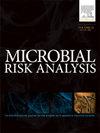具有背景菌群的芝麻菜叶片上无痕李斯特菌替代单核增生李斯特菌生长的一步动力学分析:模型建立与验证
IF 4
4区 环境科学与生态学
Q2 ENVIRONMENTAL SCIENCES
引用次数: 0
摘要
考虑到背景微生物群(BM)的存在,包括APC(好氧平板计数)、TPC(总嗜冷菌计数)和LAB(乳酸菌),本研究研究了在滥用条件下新鲜芝麻菜叶片上单核增生乳杆菌和innocua乳杆菌的生长动力学。此外,还在工业实践中评价了用无头乳杆菌代替单核增生乳杆菌的可行性。建立了预测模型来评估温度和时间对两种微生物生长动力学的影响。实验一式三次,观察5 ~ 35℃温度下的生长动力学。采用USDA IPMP-Global Fit软件对生长曲线进行一步分析,采用Huang全/无滞后期生长模型为一级模型,Huang次优(HSRM)和Ratkowsky次优平方根模型为二级模型。另外一组在15°C和20°C时收集的等温数据用于验证模型。结果表明,单核增生L.的最低生长温度为2.91±0.50°C,无尾L.的最低生长温度为2.88±0.50°C, APC、TPC和LAB的最低生长温度分别为2.05±0.89、1.93±0.98和3.55±1.97°C。单核增生李斯特菌和无毒李斯特菌的特定生长率为0.01 ~ 0.93 h⁻¹。模型验证和开发的均方根误差(RMSE)均小于0.3 log CFU/g,表明黄氏生长模型与HSRM相结合可以准确预测滥用条件下单核增生乳杆菌的生长。经过验证的模型可以为定量风险评估工具提供有用的输入,以预测在BM存在的情况下芝麻菜叶片上单核细胞增生乳杆菌的生长。本研究结果支持无头乳杆菌作为生鲜产品工业生产中适宜的替代菌,R2=0.961。本文章由计算机程序翻译,如有差异,请以英文原文为准。
One-step kinetic analysis of Listeria innocua growth as a surrogate for Listeria monocytogenes on arugula leaves with background microbiota: model development and validation
This study investigated the growth kinetics of L. monocytogenes and L. innocua on fresh arugula leaves under abusive conditions, considering the presence of background microbiota (BM) including (APC (Aerobic Plate Count), TPC (Total Psychrotrophic Count), and LAB (Lactic Acid Bacteria)). Additionally, the feasibility of using L. innocua as a surrogate for L. monocytogenes was evaluated for industrial practices. Predictive models were developed to assess the effect of temperature and time on the growth kinetics of both microorganisms. Experiments were conducted in triplicate to observe growth kinetics at temperatures from 5 to 35°C. The growth curves were analyzed using one-step analysis with the USDA IPMP-Global Fit software, employing the Huang full/no-lag phase growth as the primary models and the Huang sub-optimal (HSRM) and Ratkowsky sub-optimal square-root as the secondary models. An additional set of isothermal data, collected at 15°C and 20°C, was used to validate the models. Results showed that the minimum growth temperatures were 2.91±0.50°C for L. monocytogenes and 2.88±0.50°C for L. innocua, while 2.05±0.89, 1.93±0.98 and 3.55±1.97°C for APC, TPC and LAB, respectively. The specific growth rates of L. monocytogenes and L. innocua ranged from 0.01 to 0.93 h⁻¹. The root mean square error (RMSE) of model validation and development was less than 0.3 log CFU/g, indicating that the combination of the Huang growth model with HSRM could accurately predict the growth of L. monocytogenes under abusive conditions. Validated models can provide useful input to quantitative risk assessment tools to predict the growth of L. monocytogenes on arugula leaves in the presence of BM during distribution or storage. The findings of this study support the use of L. innocua with R2=0.961 as a suitable surrogate in industrial practices for fresh produce.
求助全文
通过发布文献求助,成功后即可免费获取论文全文。
去求助
来源期刊

Microbial Risk Analysis
Medicine-Microbiology (medical)
CiteScore
5.70
自引率
7.10%
发文量
28
审稿时长
52 days
期刊介绍:
The journal Microbial Risk Analysis accepts articles dealing with the study of risk analysis applied to microbial hazards. Manuscripts should at least cover any of the components of risk assessment (risk characterization, exposure assessment, etc.), risk management and/or risk communication in any microbiology field (clinical, environmental, food, veterinary, etc.). This journal also accepts article dealing with predictive microbiology, quantitative microbial ecology, mathematical modeling, risk studies applied to microbial ecology, quantitative microbiology for epidemiological studies, statistical methods applied to microbiology, and laws and regulatory policies aimed at lessening the risk of microbial hazards. Work focusing on risk studies of viruses, parasites, microbial toxins, antimicrobial resistant organisms, genetically modified organisms (GMOs), and recombinant DNA products are also acceptable.
 求助内容:
求助内容: 应助结果提醒方式:
应助结果提醒方式:


